Australian chicken meat industry seeks to harness the power of behavioural science

 NATIONAL CHALLENGES AND OPPORTUNITIES / Tuesday, 13 August 2024
NATIONAL CHALLENGES AND OPPORTUNITIES / Tuesday, 13 August 2024 
The report, Mapping the Workforce of Australian Agriculture, has identified ways to improve the collection, availability, specificity and accuracy of workforce data for the agriculture, fisheries and forestry sectors in order to attract and retain skilled workers and bolster productivity.
Workforce data comprises of information about the human resources of an industry, including the number of people employed, employment type, industry and location of employment, employee demographics, recruitment and retention rates, health and safety, income, and enablers and barriers to working in a specific sector.
Commencing in October 2023, Mapping the Workforce of Australian Agriculture has been led by AgriFutures Australia with support from all Research and Development Corporations (RDCs), the National Farmers’ Federation (NFF) and the Department of Agriculture, Fisheries and Forestry (DAFF).
As well as evaluating the importance and uses of workforce data, the report also considers the effectiveness of existing workforce datasets, pinpoints data gaps and needs (generated through wide ranging industry consultation) and highlights new projects and approaches underway to improve workforce data. It also includes 15 recommendations on how to enhance future workforce data collection.
AgriFutures Australia’s Manager of Workforce Policy, Tasmin Rowe, said as is the case for many other industries, workforce shortages were an ongoing challenge for Australian agriculture and attracting and retaining a sustainable, reliable, and increasingly skilled workforce was crucial for ongoing prosperity.
“It really puts the challenge into context when you realise we currently know more about the number of sheep in Australia than the number of people who work in agriculture,” Ms Rowe said.
“We have some of the most modern and thriving food and fibre production sectors in the world, with a wide range of exciting and diverse employment opportunities, in both rural and metropolitan areas, yet attracting and retaining a skilled workforce remains an ongoing challenge that must be tackled.
“The adage of you can’t manage what you can’t measure has to be our starting point and therefore we need more meaningful data about the current make up of our workforce, which will allow us to identify the major barriers more efficiently across agriculture, fisheries and forestry.
“AgriFutures Australia’s Mapping the Workforce of Australian Agriculture report provides a comprehensive roadmap for how we can achieve that through overhauling current data systems to generate accessible, quality, timely and granular data on both our current and future workforce needs”.
Despite a difficult operating environment, the Australian agriculture sector continues to expand, with the gross value of production increasing by 59% in the past 20 years. In 2021, it was estimated that at least 239,093 people were directly employed in agriculture, 17,307 in fisheries and forestry, and an additional 22,549 in support services to the sector.
In addition to the challenges shared by other sectors, the Mapping the Workforce of Australian Agriculture report has identified three priority issues for rural sectors:
ABARES Economist, Ben Slatter, said the report highlighted why obtaining reliable information on labour demand, gaps and recruitment was so important, “we need to look at ways to better integrate workforce data from our rural industries into key national datasets.”
“Those datasets need to account for and capture seasonal, casual, family member, migrant and labour hire workforces to understand and quantify sector size and dynamics,” Mr Slatter said.
Proposals for industry-led workforce data collection include designing a data aggregation brief, piloting direct data feeds, establishing a data governance framework with national custodians, and exploring advanced data tools such as AI to enrich and deliver new workforce insights.
The overall objective of the Mapping the Workforce of Australian Agriculture project is to improve the collection of workforce data for the agriculture sectors, enabling better-informed workforce strategic planning, policy development, research, and progress monitoring. This includes:
Ben Rogers, NFF’s General Manager of Workplace Relations and Legal Affairs, said the industry is committed to implementing new recommendations to enhance workforce data management and better support Australia’s agriculture sector now and into the future.
“The Australian agriculture, fisheries, and forestry sectors are planning for significant growth, with strategies outlining a target of $100 billion in farm gate output by 2030, a billion new plantation trees, and sustainable growth in the fishing, aquaculture, and seafood industries,” Mr Rogers said.
“However, for this growth to be realised, a sustainable, reliable, and increasingly skilled workforce will need to be attracted, recruited, retained and developed.
“Ongoing cross-sectoral collaboration is vital to ensure we have comprehensive data that can be used to identify workforce needs and help drive sustained growth so we can continue to feed a growing global population.”
For further information and to access the report
Media enquiries:
Ingrid Lee-Scott
Dentsu Creative Public Relations
0410 047 767
 CHICKEN MEAT / 13.08.24
CHICKEN MEAT / 13.08.24  WORKFORCE AND LEADERSHIP / 13.08.24
WORKFORCE AND LEADERSHIP / 13.08.24  WORKFORCE AND LEADERSHIP / 13.08.24
WORKFORCE AND LEADERSHIP / 13.08.24  THOROUGHBRED HORSES / 13.08.24
THOROUGHBRED HORSES / 13.08.24